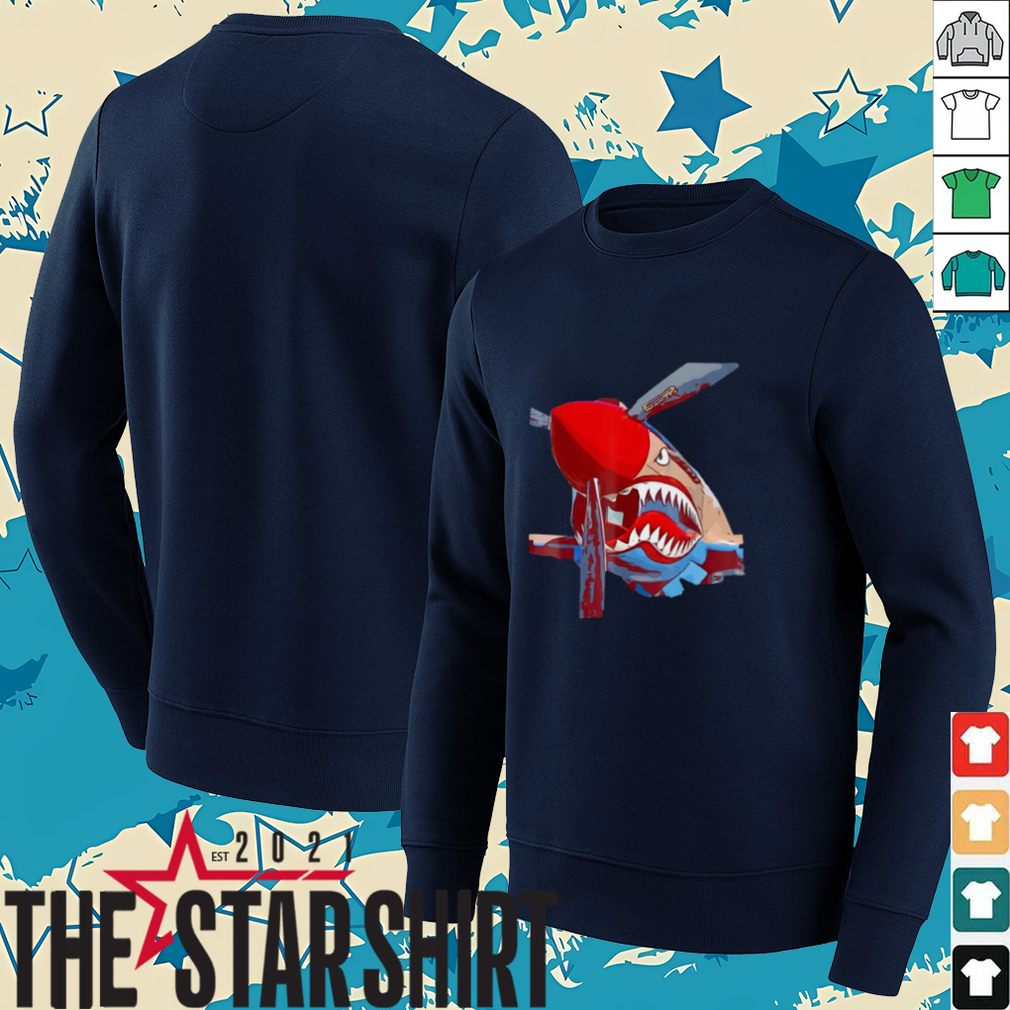“P-40 Warhawk Fighter Aircraft Shirt”: A Tribute to a WWII Icon
The “P-40 Warhawk Fighter Aircraft shirt” celebrates one of the most iconic and recognizable **fighter aircraft** of World War II: the **Curtiss P-40 Warhawk**. Known for its distinctive shark mouth nose art, particularly when flown by the legendary Flying Tigers, the **P-40** was a rugged, versatile, and essential warplane that served with distinction across multiple theaters of conflict. This **shirt** isn’t just apparel; it’s a piece of history, honoring the pilots who flew it and the pivotal role it played in early Allied air combat. It captures the spirit of resilience and daring that characterized the air battles of the era. The prominent entities are “**P-40 Warhawk**” (the aircraft), “**Fighter Aircraft**” (its type), and the implied historical context of “World War II.” Semantic keywords include “WWII fighter plane shirt,” “Flying Tigers P-40 shirt,” “vintage aviation apparel,” “Curtiss P-40 Warhawk merchandise,” “military aircraft tee,” “WWII history shirt,” “historic warplane design,” “pilot gift,” and “aviation enthusiast shirt.” The unique attribute of this **shirt** is its direct visual homage to the “shark mouth” livery, a viral trigger that instantly brings to mind images of daring aerial combat and a sense of nostalgic heroism. This **T-shirt** is perfect for aviation history buffs, veterans and their families, military aircraft enthusiasts, or anyone who appreciates the enduring legacy of World War II **fighter aircraft**. But what made the **P-40 Warhawk** so significant, why was its iconic nose art so impactful, and what were the challenges and triumphs of the pilots who flew this legendary machine?
—
The P-40 Warhawk: A Workhorse of World War II Skies
The **Curtiss P-40 Warhawk** was an American single-engine, single-seat, all-metal fighter-bomber that first flew in 1938. Though often overshadowed by later, more advanced fighters like the P-51 Mustang, the **P-40** was crucial in the early years of World War II. It was the third most-produced American fighter of the war, with 13,738 units built by November 1944 (Source: Wikipedia). The **P-40** played a critical role with Allied air forces in North Africa, the Southwest Pacific, and China, remaining in frontline service until the end of the war. Its ruggedness and reliability were paramount, allowing it to operate in harsh conditions and withstand significant battle damage. For instance, several P-40s managed to get airborne and score the first American pursuit kills on Japanese aircraft during the attack on Pearl Harbor on December 7, 1941 (Source: Hill Aerospace Museum). While not always the fastest or most maneuverable at high altitudes compared to its adversaries like the Mitsubishi A6M Zero, its robust construction and ability to execute steep dives made it effective in the right hands. My personal commentary: The **P-40** was truly a gritty, dependable aircraft. It might not have been the flashiest, but it showed up for every fight and got the job done, which is why it earned such respect from its pilots. If you like to zoom in this way, you can almost hear the powerful Allison V-1710 engine roaring as it dives into combat.
—
The Flying Tigers and the Iconic Shark Mouth Livery
Perhaps the most famous association of the **P-40 Warhawk** is with the “Flying Tigers,” the 1st American Volunteer Group (AVG) of the Chinese Air Force. Led by General Claire Chennault, these American civilian pilots fought against Japanese forces in China before the United States officially entered World War II. It was the **Flying Tigers** who popularized the intimidating “shark mouth” nose art on their **P-40s**, a design reportedly inspired by images of Royal Air Force Tomahawks in North Africa (Source: National Interest). This menacing livery, with its ferocious fangs and teeth painted around the distinctive air intake, became an instant viral trigger and a symbol of Allied defiance and aggression. The **Flying Tigers** achieved remarkable success, credited with 296 confirmed aerial victories against Japanese aircraft while losing only 23 American pilots in combat (Source: National Interest). Their P-40Bs and later P-40Es, despite sometimes being outmatched in raw performance by Japanese fighters, became formidable weapons due to Chennault’s innovative air combat tactics, which emphasized hit-and-run attacks rather than prolonged dogfights. The story of “Tex” Hill, a triple-ace who flew both with the AVG and later the US Army Air Forces, is just one example of the heroism displayed by **P-40** pilots (Source: Military Aviation Museum). For another shirt that represents a sense of belief or conviction, though in a different context, consider the “Believe Rabbit Head Shirt” which highlights a more whimsical yet profound statement.
—
Legacy and Specifications of the P-40 Warhawk
The **P-40 Warhawk’s** legacy extends beyond its combat record; it represents the critical role of American industrial might and innovation in the early stages of World War II. Thousands were built and exported to Allied nations including Britain, the Soviet Union, Australia, and Canada, where they were known as the Tomahawk and Kittyhawk (Source: Wikipedia). The P-40’s design philosophy emphasized ruggedness, heavy armament, and pilot protection, including self-sealing fuel tanks and armor plating. Here’s the part they didn’t tell you: while often criticized for its lack of a supercharger in early models, which limited high-altitude performance, its lower-altitude capabilities, dive speed, and ability to absorb damage were often more critical in the theaters where it primarily served. Key specifications of the P-40 (models varied): it was typically powered by an Allison V-1710 V-12 liquid-cooled engine, producing around 1,090 to 1,240 hp (Source: Pacific War Online Encyclopedia). It had a top speed of approximately 357-378 mph, a range of around 700-900 miles with drop tanks, and was typically armed with six .50 caliber machine guns in its wings, along with external hardpoints for bombs (Source: Military Aviation Museum, Pwencycl.kgbudge.com). The **P-40 Warhawk Fighter Aircraft shirt** serves as a tangible link to this incredible machine, reminding us of the ingenuity and bravery that shaped the course of history.
Follow-up Questions:
- Beyond the Flying Tigers, which other Allied air forces made significant use of the **P-40 Warhawk**, and what were their notable achievements?
- How did the various modifications and variants of the **P-40 Warhawk** (e.g., P-40B, P-40E, P-40N, Kittyhawk, Tomahawk) impact its performance and operational roles throughout WWII?
- What specific tactical innovations were developed by pilots and commanders to maximize the **P-40 Warhawk’s** strengths and mitigate its limitations against superior enemy fighters?
- Are there any preserved or airworthy **P-40 Warhawk fighter aircraft** that aviation enthusiasts can visit or see in flight today?
- How does the **P-40 Warhawk** compare to other Allied fighters of its era, such as the Spitfire or Hurricane, in terms of its design philosophy and combat effectiveness?






























